Volvo and BMW aren’t natural rivals. They’ve bumped door handles on the race track over the years, though not for a while, and they haven’t been direct showroom rivals but that’s changing with Volvo now aiming higher in terms of luxury and desirability. BMW’s new X3 range will be cross shopped with the XC60, similar are they in size, price and relative exclusivity.
We should preface this comparison by saying the XC60 T6 R Design is a late stand-in for the Audi SQ5, which Audi cancelled on us. So thankfully Volvo could rustle up a T6 at short notice, and we were glad to be back in its sumptuous seat again. So while the new X3 M40i and the XC60 T6 might not be perfect combatants, the hard-charging X3 will be a stern test for the Polestar optimised R-Design variant of our Car of the Year in the $60k-$100k area. But first a little more on the X3.
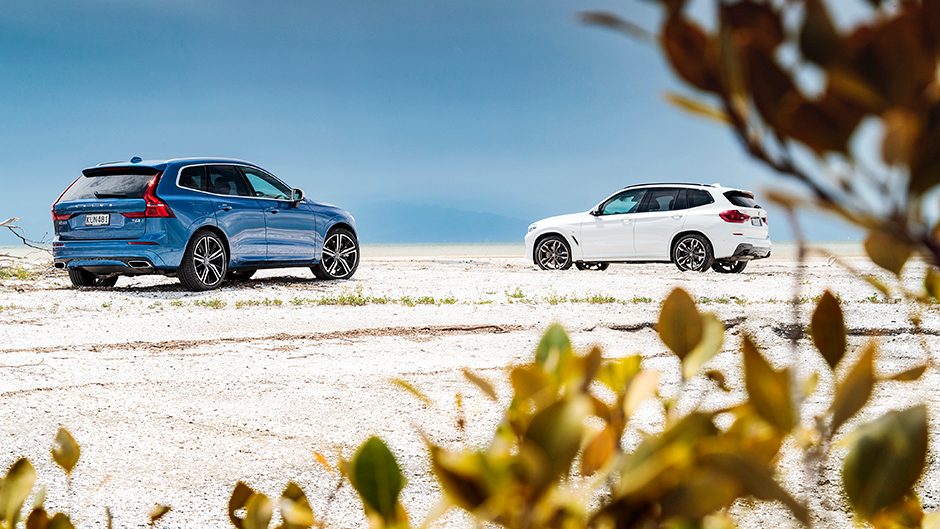
X3 the third and a bit about the Volvo
The new model certainly looks familiar while dimensionally it fits neatly between the X1 and X5. It’s ever so slightly bigger than the old model but weight reduces marginally (by a claimed 55kg) despite extra refinements and features being added. Inside you’ll notice the biggest change with a more premium cabin sporting extra gadgets.
The X3 range starts with the 20d (140kW/400Nm) at $92,850, the 30i (a 2.0 turbo four making 185kW/350Nm) is $99,850 and the X3 M40i is $119,850, aimed at the likes of the SQ5, and Merc’s GLC 43. It’s the first time there has been an M offering in the X3 range, this being of the M performance flavour with a 3.0-litre straight-six turbopetrol developing 265kw and 500Nm. The M40i is distinguished by its M aero kit and its electroplated cerium grey highlights. These look good all polished up but mark easily, making them a high maintenance feature. Along with the big wheels (expect a constant battle to keep these clean) and enlarged brakes, there’s a sizeable soundtrack courtesy of the sports exhaust system.
BMW says it has reduced the unsprung mass for the X3 range by adding more alloy suspension bits and hollow tube roll bars. It’s stabilised the front geometry for improved steering, and fiddled with the rear roll centre for added bite in bends. The xDrive, fully-variable AWD system features a lighter rear differential and a modified transfer case for improved efficiency. In the case of the M40i, the system runs more of a rear-drive bias and features improved ESP tuning to aid traction. The M40i also adds variable-ratio sports steering and M suspension but thankfully the adaptive kind to maintain ride civility.
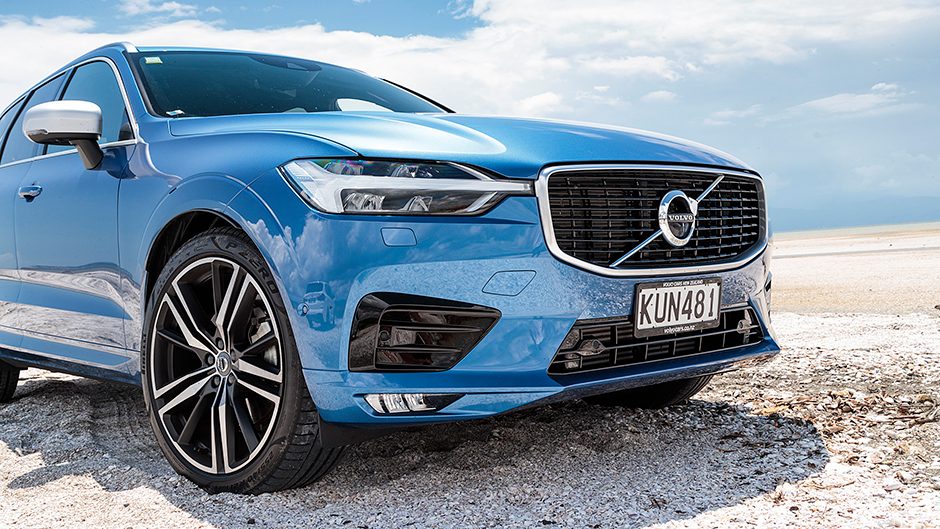
The T6 is the penultimate XC60, the T8 hybrid topping the range, and in R-Design guise its 2.0-litre super- and turbocharged four cylinder is ‘optimised’ by Polestar. They electronically massage the engine output, with a particular focus on the midrange, and tweak the software for the throttle map to enhance sporty driving. They also reprogramme the gearbox for faster shifting. Along with fewer cylinders than the BMW, the T6’s four is positioned across the engine bay, and the AWD system is of the on-demand type, variable but without the same rear-drive bias as the BMW. Torque vectoring by brake is employed to help curb understeer. This T6 is fitted with the optional air springs, which is all but a mandatory option for buyers as it adds a Drive Mode button and variable ride height, lowering in Dynamic mode with added ground clearance in the Off Road setting.
Talking dynamics
The T6 is quite the charger. The accurate steering reacts quickly and though light on weight, there’s just enough interaction to keep your interest so you can load those 21-inch P Zeroes right up to their limits. The torque vectoring does a fine job of hiding its influence and this XC60 can attack bends with more vigour than you’d give it credit for. The Dynamic mode adds firmness to the air springs and drops the ride height to reduce roll yet always remembers to maintain a good ride quality, nasty ruts and holes dispatched without worrying the bump stops. It’s a sporty drive but always one with a comforting layer of refinement.
For quick hill work, the auto does well but operates better via the paddles to ensure it holds the desired gear. The downshifts need some polish, and while it’s not a true manual mode (it still changes up at the limit and kicks down), neither is it frustrating. The engine’s delivery below four thousand attends to most duties, while the additional 2500rpm at the top end is the cherry. Its get up and go belies its capacity but then with a mechanical blower and the exhaust driven turbo, Volvo squeezes a lot from the unit, and that torque curve is very flat, a bit like the engine note, but hey, guess you can’t have it all.
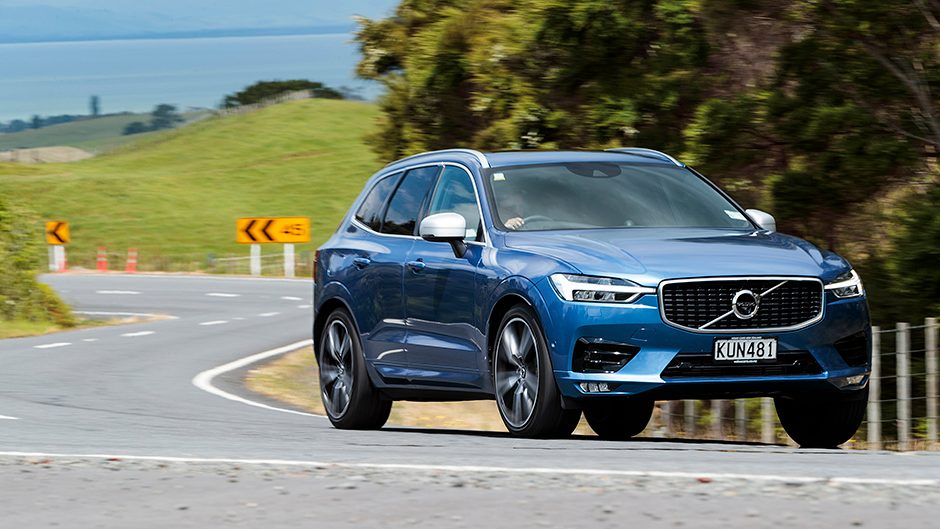
The X3 M40i however is that bit faster and sharper dynamically. It certainly lives up to its M badging. The steering isn’t buzzing with action but it has more meat to its action, and a quicker response, the front end pointing about more keenly. The BMW has a higher threshold for cornering pain, the Bridgestone’s providing plenty of adhesion and a good feel for the edge of grip. The electronic dampers set in Sport mode deliver a stiffer ride and a few more bumps but also better control in quick and tight running. The X3 is better balanced and handles a bigger lateral load when you lean on it.
BMW is big on drive modes and this has five, including Sport and Sport Plus, along with an Adaptive setting which is good for a winding road at a more sedate pace. The auto is smarter and faster at shifting, and its Sport mode is tuned perfectly for when the occasion calls. Guess it’s no real surprise the larger capacity engine delivers a bigger punch. It starts with its racy idle on start-up, and even by 2000rpm this engine is feeling frisky while it howls in true straight six style around to just shy of 7000rpm. With more pistons slugging away on the crankshaft, the six delivers a firmer shove and its top end is stronger. It is quick this, shading the T6 comfortably in a straight line. The flip side is its appetite for fuel, the X3 up into the high 14s, the Volvo in the low 12s.
The M40i then?
If it’s the sharper SUV you’re after, yes it’s the athlete here, but there’s more to consider. The T6 R-Design starts at $97,900, and even this tester with the Premium Pack (air suspension, heated front seats, power folding rear back seats and headrests, premium B&W sounds and tints) and a panoramic roof and laminated side windows is $109,765 making it much cheaper than the X3. The BMW by contrast costs $131,050 with options. Both run a similar spec; active LED lights, multi-zone air con, auto tailgate, smart key, a full suite of driver assistance aids, head-up display and surround view camera. The Volvo’s infotainment system includes Carplay and Android Auto as standard though BMW adds its connected services, a wireless phone charger and three years of scheduled servicing.
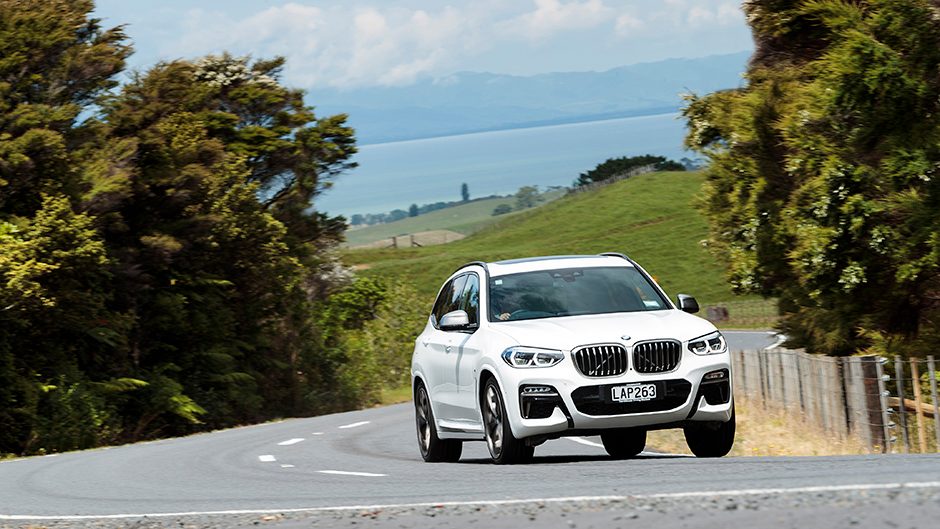
Volvo a charmer
If you’ve poked your nose in the XC90 or S90, the XC60’s cabin will be familiar, and that’s no bad thing. The R Design is an all black affair, with alloy used for effect. It’s hard to find hard plastic in this cabin while the high-mounted centre console is lined with carpet. The seats, a fine mix of leather and suede, are well supportive and multiway adjustable. They’re heated too. The finish, quality and functionality are tops, with useful storage, and the Sensus infotainment system is quick, the screen vibrant and the portrait orientation displays information, especially the nav map, better. We like it, even if some functions require a couple of inputs to achieve. The 360-degree camera function needs improving though, the image being a little distorted.
The X3 has had a massive lift in cabin quality and design. There’s now much less in the way of hard plastics about (though still more than in the XC60) while added design elements raise the ambience. This M40i gets faux leather trim on the dash top and doors, and the stitching and brightwork help lift the luxury feel. It even has good storage space for a BMW. The screen is wide and the resolution sound, while the parking camera with its multi-angle view and the superimposed car on screen give a clearer picture of your surroundings. Some will appreciate the presence of actual buttons for the radio and ventilation controls. The seat is a bit firm but thankfully not too racy in its lateral support, and there’s a better range of adjustment. While the X3 is much improved, it still lags behind the XC60 in terms of panache and quality feel.
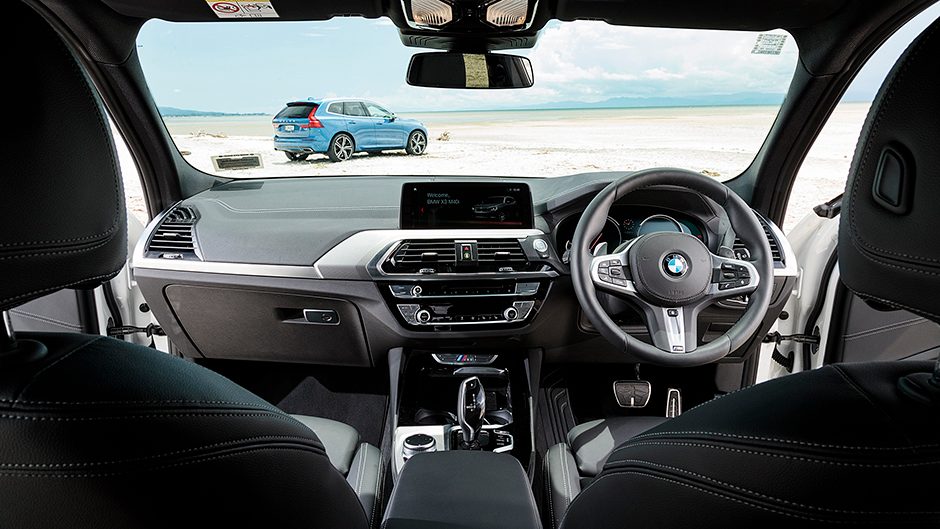
Each has good leg- and headroom in the rear, access a little tighter in the XC60, and with its more sculptured seating, you’re more likely to squeeze three in the back of the BMW, if the middle person can deal with the big trans tunnel. The XC60 lacks Volvo’s usual integrated booster seats, though it says they are coming. The Volvo’s boot is a mite wider, but overall they are similarly sized, and both split fold easily, the XC60’s load area slightly flatter and longer.
Easy and safe
As you’d hope, these make easy going daily drivers. The Volvo always has the more comforting ride, and the lighter steering action, the BMW, even in Comfort mode gives a gentle reminder of its sporting intent. Both have a lot of basement mumbo for easy commuting, neither with any lag moment to note while the BMW’s stop/start system isn’t as active as the Volvo’s, the one minor annoyance with the XC60, though you can turn it off.
Both active cruise systems can handle queued traffic, and both feel a little odd when the active lane keeping is in action; you wonder who is in control of the wheel here. The BMW is better at keeping centred in the lane, but both systems can drop in and out depending on the condition of the lane markings, so it’s best to remain vigilant and always indicate when merging or the systems will try to steer you back into the lane. With speed limit recognition, the X3’s cruise control can be quickly reset to the new limit with a touch of the button while Volvo’s camera had a hard time reading variable LED signs, consistently detecting 80km/h signs as 60.
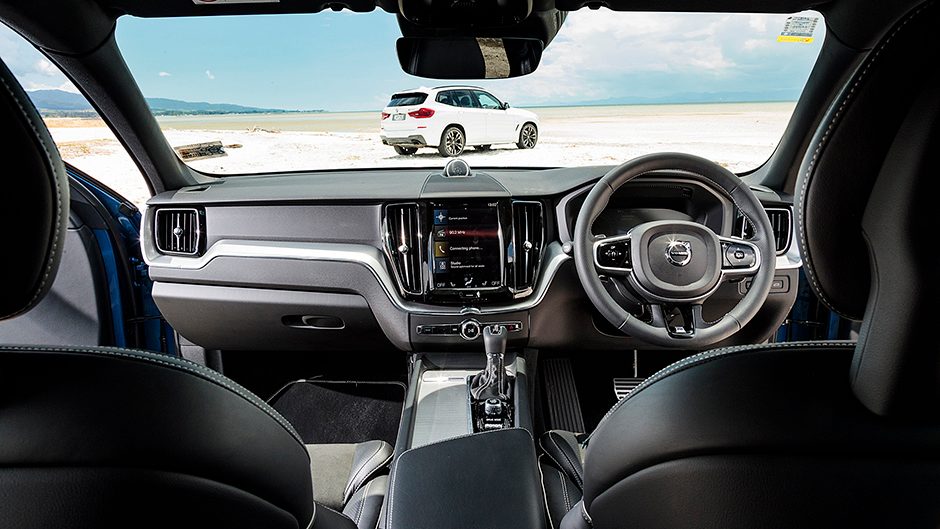
So which one?
As already stated, the performance SUV choice is the BMW, quicker and sharper in every way, it’s engine a pearler. Added cabin refinements improve the X3 as well. But some will look at the relative value of the Volvo here, it’s more pleasing aesthetic, both inside and out and deem its performance and dynamics to be more than adequate for day to day life.
Tough call.
| Model | Volvo XC60 T6 AWD R-Design | Price | $97,900 |
| Engine | 1969cc, IL4/T/SC,246kW/440Nm | Drivetrain | 8-speed auto/on-demand AWD |
| Fuel Use | 7.7L/100km | C02 Output | 176g/km |
| 0-100km/h | 6.11sec | Weight | 1964kg |
| Model | BMW X3 M40i | Price | $119,850 |
| Engine | 2998cc, IL6/TT, 265kW/500Nm | Drivetrain | 8-speed auto/AWD |
| Fuel Use | 8.9L/100km | C02 Output | 204g/km |
| 0-100km/h | 4.81sec | Weight | 1952kg |


